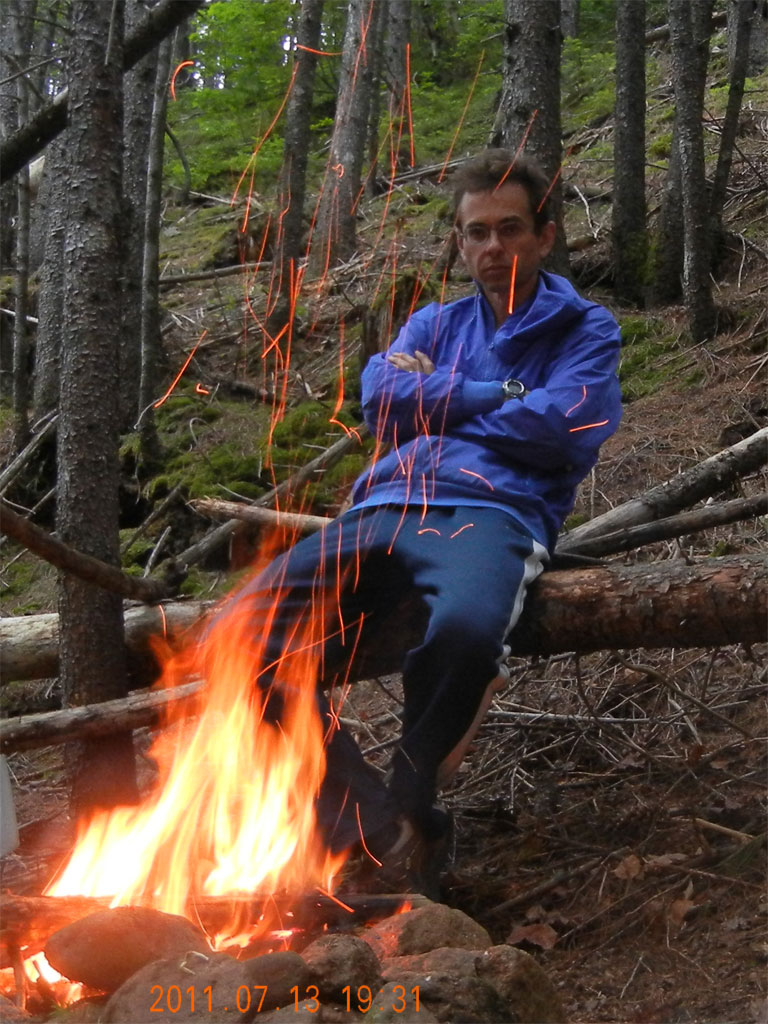 Completely alone in the woods. For many miles around. I didn’t see a single person on the entire wilderness portion of the trail. And now, as planned, it is my first night in the White Mountains is closing in around me.
Completely alone in the woods. For many miles around. I didn’t see a single person on the entire wilderness portion of the trail. And now, as planned, it is my first night in the White Mountains is closing in around me.
Even now it seems strange to remember all the nervous mental preparation inside. It started around 3PM that day. I suddenly realized that for the next 12-15 hours I will not meet another person, and I would have to rely completely and entirely on my own.
The sun was on and off behind disturbing dark clouds. The bugs were intense and preferred to ignore the spray. And of course – loneliness. AT&T phone displayed “No Service” even on the 302 parking lot. Miles and miles around there are no phones, no electricity, no people, no roads.
Finally I’ve got what I wanted, and all of a sudden I had doubts about the whole enterprise. But let’s go in order it was perceived.
Arrival Day – Deposit Bike into the Woods
USA. New Hampshire. White Mountains. Summer of 2011.
I drawn the whole trip on the map. From route 302 I took a Sawyer Pond Road and drove a little over 3 miles into the woods. Right after the second bridge, but before the trail-head parking for the Sawyer Pond Trail I found a gate marked 85 for Fire Road 85.
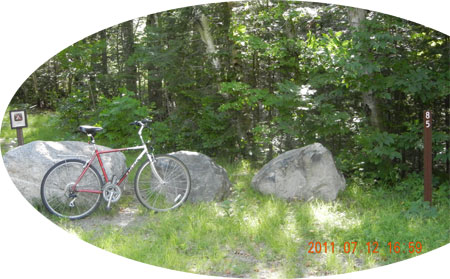 This road disappeared from many guides and maps long time ago, but somehow was marked on my map. It is barely a road anymore. It is blocked by fallen trees and branches, but overgrowth and by water erosion (deep ditches). But it is still visible, although completely unused. Only a faint narrow path goes along on of the sides, and this “road” is completely unsuitable for the bike.
This road disappeared from many guides and maps long time ago, but somehow was marked on my map. It is barely a road anymore. It is blocked by fallen trees and branches, but overgrowth and by water erosion (deep ditches). But it is still visible, although completely unused. Only a faint narrow path goes along on of the sides, and this “road” is completely unsuitable for the bike.
It took me over an hour to get through 2 miles of “obstacle course” with a bike and full of doubts and mosquito bite, I finally found an intersection with the the trail – Signal Ridge Trail. The road is easier to miss, The trail is a wide flat road passing on the bed of the former rail road.
A quick fast dash deeper into the woods, hide the bike, and take a swim in the river – Carrigain Brook. After a swim your cold body is invisible to bugs for a few minutes. What a bliss. Time to dress up, and walk back to the car. I know it took me from 18:33 to 19:08 to walk briskly back on fire road 85. It is so much faster to walk instead of crawl with a bulk of a bike.
First Night – Dry River Campground
I wanted something very inexpensive and something very close to the starting point of my trip tomorrow. What could be better than Dry River Campground – $25.
It is located right on route 302, right in the middle of it all. After erecting the tent, I cooled off in a very shallow river (3 minutes away) and took off for supper to Fabyan Station Restaurant (10 miles away). If everything goes according to plan, it will be last civilized meal for me for the next day and a half.
Around 22:22 I am back in the tent. This time I remembered ear plugs and eye covers to completely block outside world and sleep like a log. It was warm. It was very warm Summer night that confused me. How could I thing that it could be cold anywhere on the planet earth.
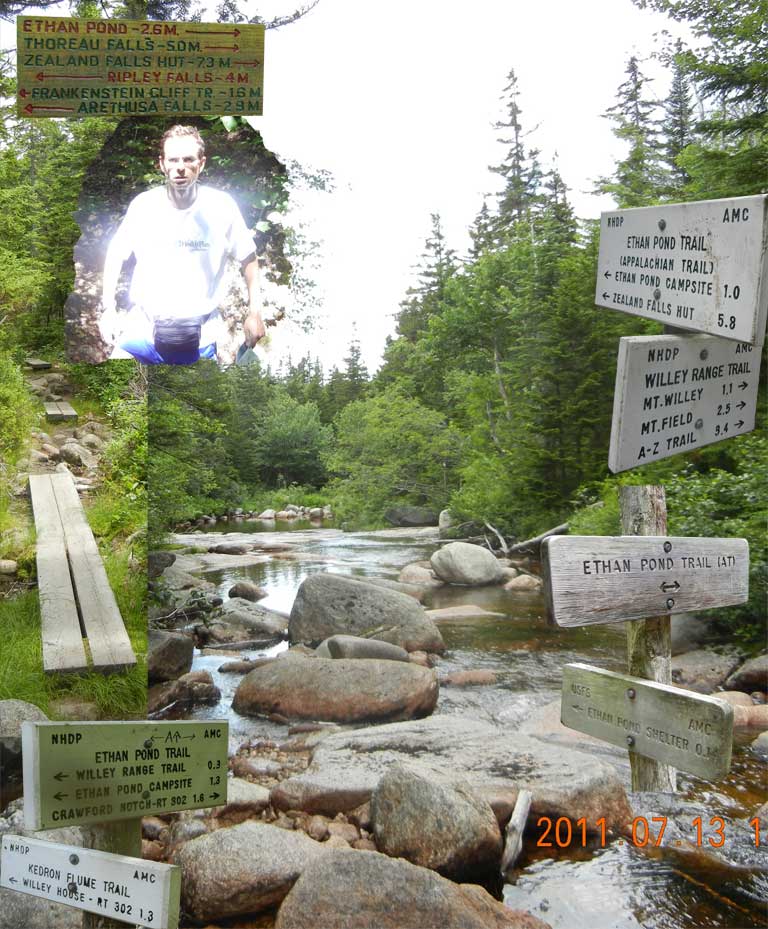 Day Two – Start the Hike
Day Two – Start the Hike
It is hard to start the hiking trip. How much water to pack? Do I need a sleeping bag? How all this stuff on the ground is going to fit into a backpack?
Parking for Ripley Falls is .25 miles away from the main road and you gain some elevation while driving there. Parking is free and donation envelopes only suggest the payment. Most people are tourist with only water and camera in their hands. Picturesque falls are 20 minutes away, but they are not the target of this trip.
Around 10:40 I started climbing up with a heavy backpack unbalanced by a tent. Ethan Pond Trail here coincides with Appalachian Trail, but that is not a particularly impressive section. First hour of the Ethan Pond Trail goes parallel to 302, and you can hear muffled sounds from the road. Meanwhile you are climbing from about 2100′ at Parking lot to 2500′ level at the merge with Kedron Flume, and to 2700′ at Willey Range trail. Bugs are persistent, but moderate. Trail itself is nothing to write home about.
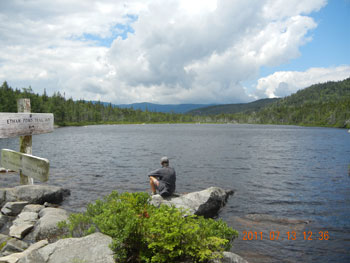 Around 11:50 trail make a turn away from the road into the depths on the forest. You continue to climb another 20 minutes and by 12:12 you at the highest point of your trip – 2929′. You’ve reached a pass into other side, and all rivers and brooks will flow with your movement down.
Around 11:50 trail make a turn away from the road into the depths on the forest. You continue to climb another 20 minutes and by 12:12 you at the highest point of your trip – 2929′. You’ve reached a pass into other side, and all rivers and brooks will flow with your movement down.
Just recently I discovered that a standard GPS Unit from Garmin even without topographic maps loaded will detect an elevation, when you save your current location as a Favorite. You you save you location regularly during the hike, you can see a nice trajectory of your trip on plain blank space between the auto roads. Elevation is an estimate of course, it tend to jump up and down a bit, but still it is a very interesting tool to figure your comparative elevation.
You reach Ethan pond and tent sites ($8 per night) around 12:30 – less than 2 hours into the trip. There is only one point of approach to the pond – through the appendix leading the the shelter, and the tent sites. They are located about 100 yards (90 meters) from the pond.
At this point Ethan Pond trail looks like a board walk. You hop from plank to plank to avoid muddy spots. Kind of fun. There are a few people at the pond and you can meet an occasional group of hikers further down the trail. But by 14:00 the trail meet the river (an excellent swimming spot), and by 14:24 you reach the Shoal pond trail and entrance to Pemigewasset Wilderness. Do not expect to see any people from that point on.
Enter Wilderness and Solitude
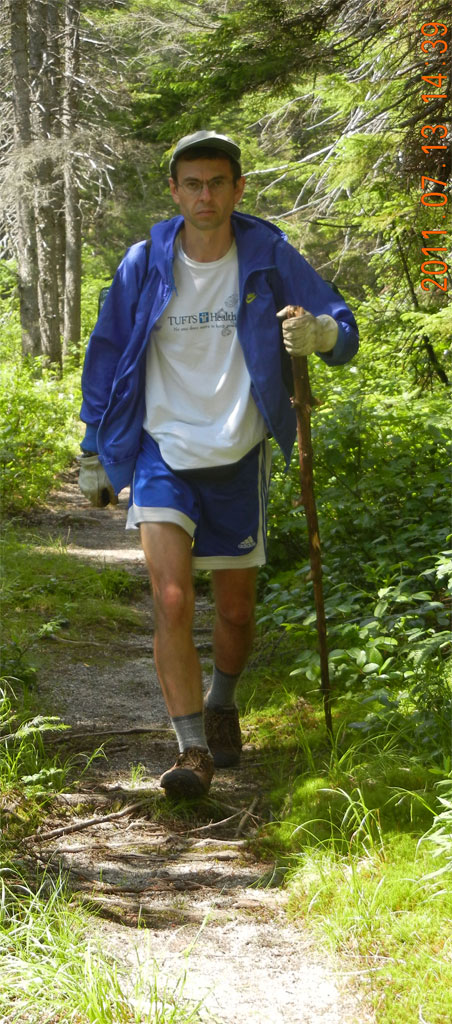 All entrances to the wilderness are marked with a familiar signs. For me it will third entrance into the area, but this time I decided to spend a night here.
All entrances to the wilderness are marked with a familiar signs. For me it will third entrance into the area, but this time I decided to spend a night here.
I deliberately picked a flat route. The purpose here is to penetrate as deep as possible into the wild, spend as much time here, but not to conquer some hills.
First significant stop here is Shoal Pond itself (2685′). I’ve reached it by 14:57 – 4 hours into the hike. The water is very warm, but this is not a great place to swim. The bottom is slimy, and water is reddish and shallow. But the setting is wonderful and somewhat disturbing. There are more hove prints than human boot prints on the path, and here I for the first time realized how far this is from any normal setting.
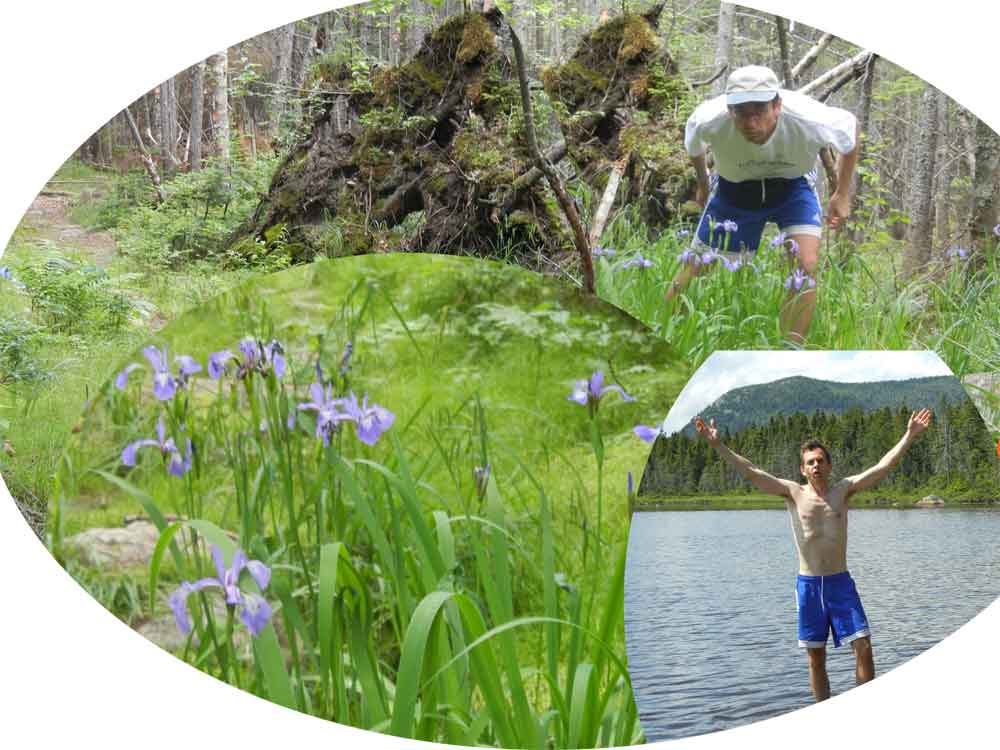 The patchy clouded sky contributed to the tone. Rain tried to start several times, but couldn’t find the strength. Very characteristic moose droppings are covering the path with an amazing regularity. Bugs are are getting more persistent and daring. And instead of listening to the sounds of nature, you begin to hear things.
The patchy clouded sky contributed to the tone. Rain tried to start several times, but couldn’t find the strength. Very characteristic moose droppings are covering the path with an amazing regularity. Bugs are are getting more persistent and daring. And instead of listening to the sounds of nature, you begin to hear things.
I was planning to take it slow, and contemplate every step of the way in the wild. Instead, I begun to hurry, to cover as much distance today, so I have less to track tomorrow. A typical error. I only stopped once to take pictures of flowers, and mostly because a sight of a huge bear turned onto a trunk and roots of a fallen tree.
The rule is you need to pick your camping spot 200 feet away from the trail, but that is not a easy task, if you are surrounded by a dense forest of both sides of a narrow path. Starting from 16:00 I’ve started to search for such a spot, but always was pushed forward by conviction that I will find something better just around the corner.
Finally the trail crossed the river one more time, and the whole bunch of excellent sport opened up right next to the path. I dropped my stuff on the ground and went searching for a more secluded camping spot. I was going to follow the 200 feet rule for two reasons. First, it is good for the rule. Second, it is good for me. I do not want to see or hear another person, or mammal near my camping spot.
I crossed the river (Shoal Pond Brook) and found a very tiny, but sufficient area for the tent and for the fireplace. GPS showed elevation of 2388′.
Evening in the Woods – Too Short, Too Fleeting
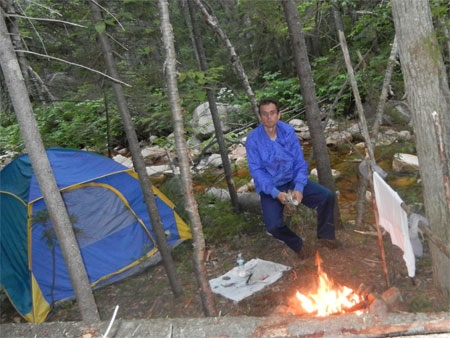 I though I had enough time to set a tent, to start a fire, to eat and to contemplate the new environment. However time in the wild has its own dimensions.
I though I had enough time to set a tent, to start a fire, to eat and to contemplate the new environment. However time in the wild has its own dimensions.
You think that wild life will disturb and bother you, while you are here. Not at all. Wild life has its own life to live, and it is totally unconcern about yours.
I picked a spot tightly squeezed between the river and a steep hill. With only a few square yards to settle, the spot felt very well positioned and even isolated. That is important to pick a spot to your liking.
Next was the fire. The fire has to be surrounded by stones to prevent it from spreading, or even lowered into the ground for safety. Brook provides an unlimited supply of stones of all size and shapes. I saw a real danger of a forest fire in a wild setting like this. Dead wood – dry and ready to go – was spread evenly all over. I surrounded the flames with large stones from the river and removed all the dry debris a foot around the fire.
With fire going, I could begin to dry of my clothes, and cool off after 6 hours of hiking. The brook again. Water is cool and refreshing, but not freezing. Just right. Wash off all bug spray, and sweat, and muscle tension. Only now I notice that my shoulder are really sore from the backpack straps. I didn’t feel much of a load during the day.
I filled a plastic bag with water from the river and hang it near by the fire to extinguish any unruly behavior. All in all you almost have to set your camp near the running water source. The brook here was a cooling off place, source of stones for the fireplace, source of water to put off the fire, soothing sound source and natural obstacle forming one side of my camp.
Next I was ready to proceed with food and drink, I realized that I am not that hungry, and that I didn’t drink anything the entire day. My two Poland Spring bottles remained untouched. And I didn’t feel the thrust. Very strange.
This part is very hard to write. You feel like you are not writing the important stuff. That is what happens with many travel notes. They deal with minutia while skipping the reasons that brought us here. And my quest was drive by question “Can I do it?” The answer begins to emerge: “Yes, I can, but this is so hard, so fleeting and uncomfortable. Next time I would need to work on allocating more time and creating more comforts – place to sit, some primitive table, sleeping bag.”
I didn’t cook anything. I ate an orange, couple bananas, smoked salmon with bread, I drunk half a liter of water and was ready to go to sleep around 20:00. It was pretty warm and comfortable. With ear plugs I went to sleep without ant difficulties.
The Night in the Woods – Cold Moonlight and Warm Fire
There is no solid surfaces in the wild. They all hidden by the forest. There is no flat surfaces in the wild. They all angled to the sun this way and that. So, there is nothing to hold on to the day the warmth. As soon as sun disappears, the cold steps in and embraces everything by a still moist grip.
I woke up from the cold. I was shivering. I put on all the clothes I had with me, I created some layering with crumpled parer, and decided to look at the watch. I thought it must be around 3AM. To my surprise it was 23:56. I probably only slept two hours and was fighting with cold the rest of the time.
By 2AM the cold was unbearable. And everything by this time was covered with dew – damp and cold. I decided to get outside the tent and start the fire again. The moon was begging to make its appearance, but only saw a moonlight on one of the steep brook bank. It was intense light , and a welcome sign as any light in the darkness of the forest.
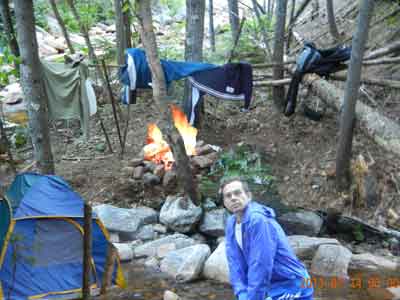 The matches seemed wet and un-cooperating, but the second one finally gave a flame, and the fire started easy and reassuring. I only felt heat in relative proximity to the fire. How do I translate that head into a comfortable sleep for the remained of the night?
The matches seemed wet and un-cooperating, but the second one finally gave a flame, and the fire started easy and reassuring. I only felt heat in relative proximity to the fire. How do I translate that head into a comfortable sleep for the remained of the night?
The idea came slowly. I would need to heat up the boulders around the fireplace and bring them into the tent to give me warmth for several hours. The problem was only with secure enough surface that will withstand the heat, and isolate tent floor from damage. I placed cold stones first as an insulator, and hot stones on top as a heat source. At 3AM I was back in the tent, and I could feel the invisible waves of energy reaching for me.
I definitely got some minutes of sleep, but the warmth did not last long. At 5:15AM I emerged from the tent into the morning light, and only wanted to start a new fire and start moving again. And again I was not feeling any hunger or thirst. Very strange. The body was distracted by all the new sights and sounds.
Hike Back to the Bike
I started the fire for the third time and begin evaluating, if I wanted anything to eat. Not really. I had about half a bottle of water left, I didn’t want to drink the reddish water from the brook. I’ll plan to get a better water at Stillwater Junction in the Pemigewasset River.
Daylight has it definite advantages over the stillness of the night – you can see and identify things. Early morning has another important advantage in the woods – all the bugs are resting from their hard work. So, no bug spay is needed at this ungodly hour. Wonderful.
By 06:40 I was on my way, and I witnessed all the magic of a fresh morning mist, and the trees masterly lighted by the early sun. By 07:07 I’ve reached the Stillwater Junction, and that gave me a first firm estimate that I can reach the bike before noon.

Here I spent some time. I force myself to eat some yogurt mixed with Grape Nuts (kind of a hard serial). I’ve collected water in empty bottles, and this time it was crystal-clear. Early morning bliss was quickly ending. Bugs reappeared again in a warmer air. Plus a normal rush to return, to escape out of the wood begin to take over all other emotions.
I quickly realized that I can make 0.8 miles in 15 minutes, and I immediately started to divide and multiply to see when I will be on the other side of the woods.
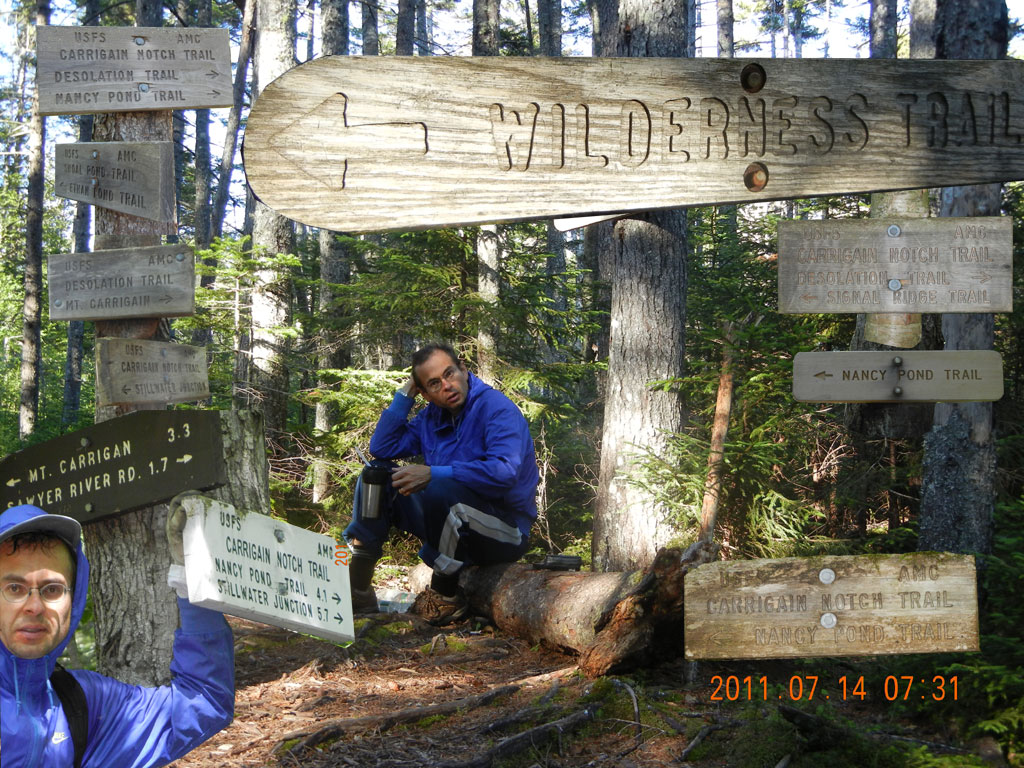 Carrigain Notch Trail is unremarkable enough. It is connecting dots and providing access to other trails. At 09:26 I’ve reached the pass to the other side of the valley and the border of Pemigewasset Wilderness. Here mosquitoes were simply wild. I only had a few inches of face open to see where I am going, but they would attack my glasses, lips, eyelids, eyebrows. Bad bad timing for this trail for this season.
Carrigain Notch Trail is unremarkable enough. It is connecting dots and providing access to other trails. At 09:26 I’ve reached the pass to the other side of the valley and the border of Pemigewasset Wilderness. Here mosquitoes were simply wild. I only had a few inches of face open to see where I am going, but they would attack my glasses, lips, eyelids, eyebrows. Bad bad timing for this trail for this season.
Last Efforts to Get to the Car
At 10:21 I was at a junction with Signal Ridge Trail, and at 10:33 I was riding the bike down down back to Sawyer River Road. Only here I begin to see people going in on a hike and surprised to see me on a bike. For a while road was excellent, but nothing lasts. Pretty soon I ‘ve notices that my front tire was flat, and trail became rugged and un-drivable.
I stopped to dip into the cold water, to cool off and to repair the front tire. This time I did have a spare tube with me. I examined the tire and found not one, but 3 thorns protruding through the rubber. Nasty little things. I learned the hard way to always examine the inside of the tire inch by inch before installing a new inner tube.
By 12:00 exactly I escaped from the woods. I was on the downward road to route 302. The speed was excellent. I only had to break to slow down. But on the hot surface of the road movement were harder. Most likely dehydration finally caught up with me, and I was advancing very very slowly on the last leg of my journey.
I needed to go about 12 miles to the car, and it took my hour and 45 minutes. And the first 3 miles I flew down in 9 minutes. So the last few miles were very slow and hot. By 13:45 I climb the appendix from the road to the car, and added a last dot to my 2 day journey. Can’t wait to get back and explore some more.
Conclusion and Amplification
What lessons to learn from all of this?
Right on the parking lot before leaving for the trip, I did talk to man returning back with his 3 sons from an overnight stay. I asked him what is the most important thing I might forget, and he said – water. I did ask about the bugs and about the cold. And they did confirm that sleeping bag is a must. But did I pack it? – No. I packed too mach food, but I didn’t take enough water and I didn’t take a sleeping bag.
Let’s learn from this.
If you are returning back to your car on the bike – you do need a sun screen. You do not need it in the thick of the woods, but on the road, the sun is beating up on you from top and is reflecting back from the road. You are exposed. Let’s learn from this too.

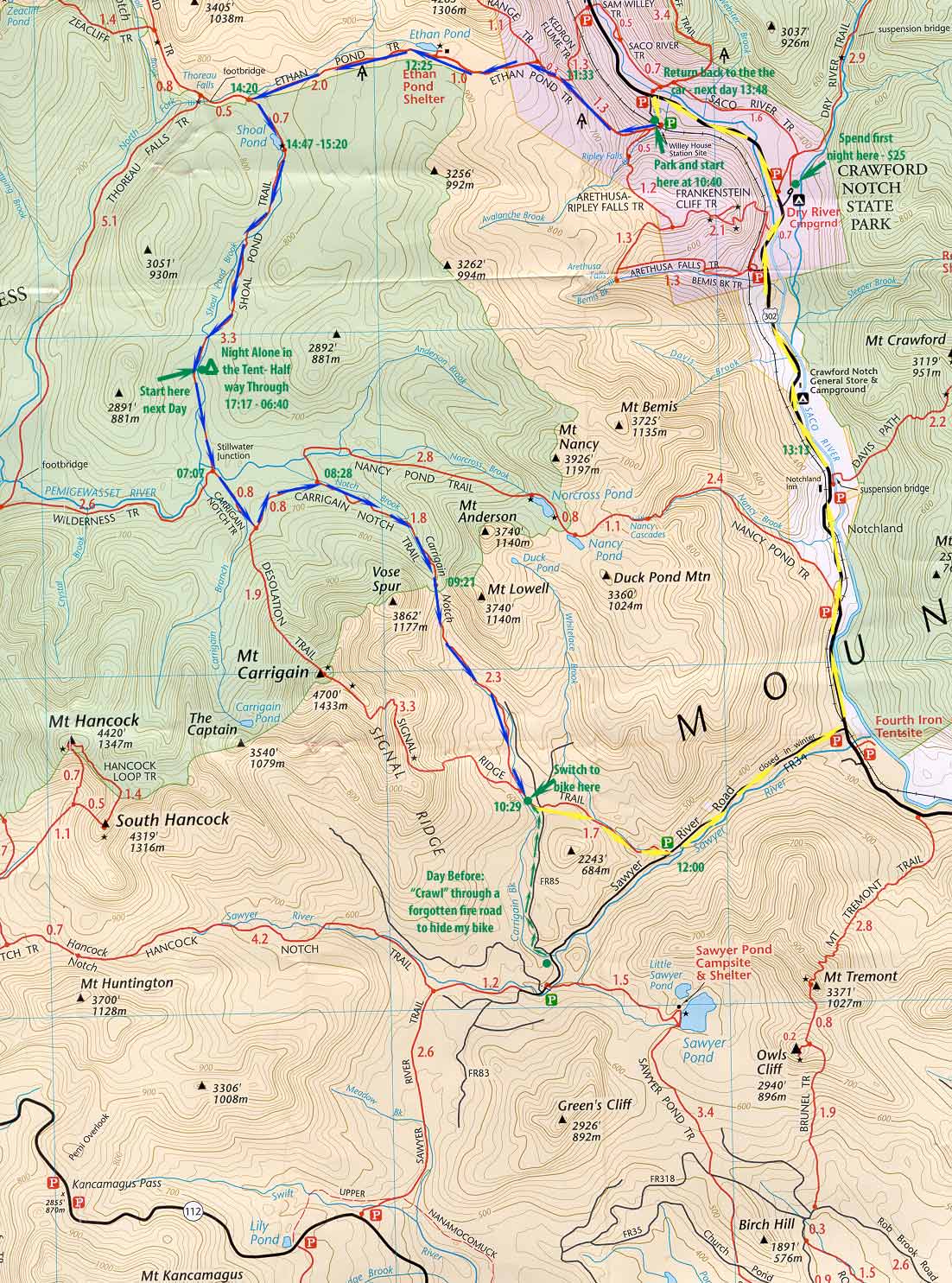
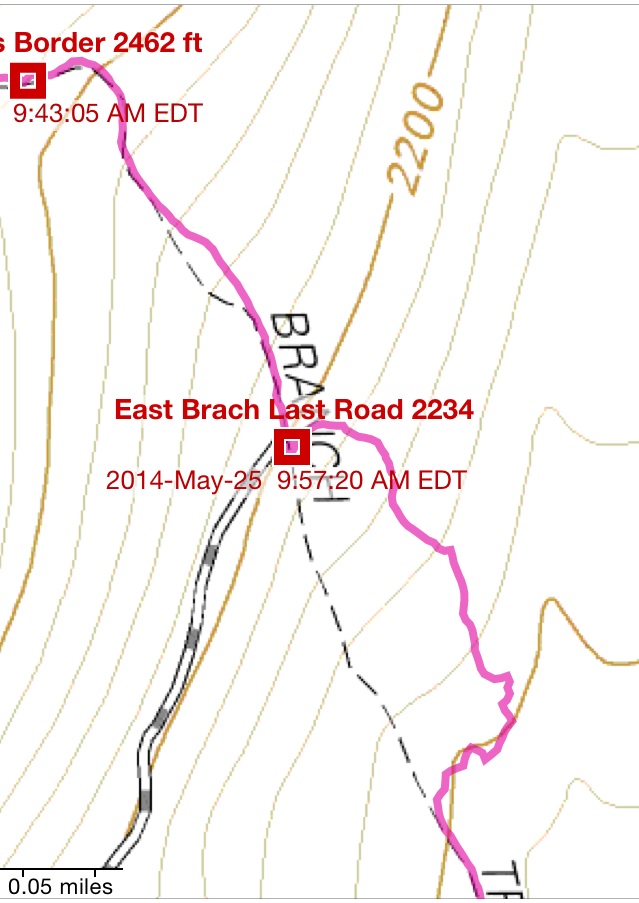
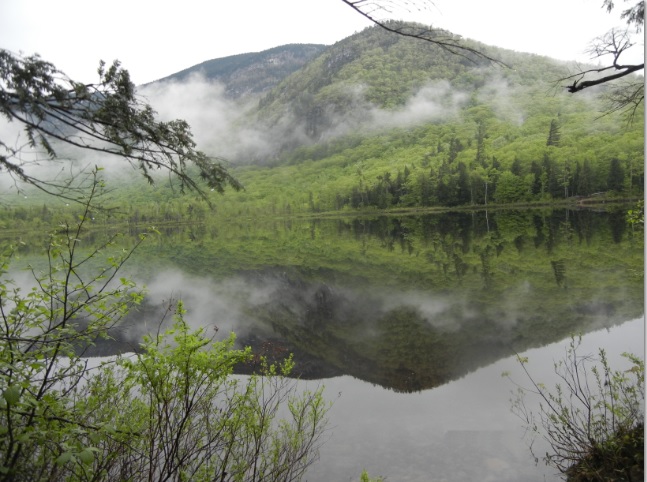
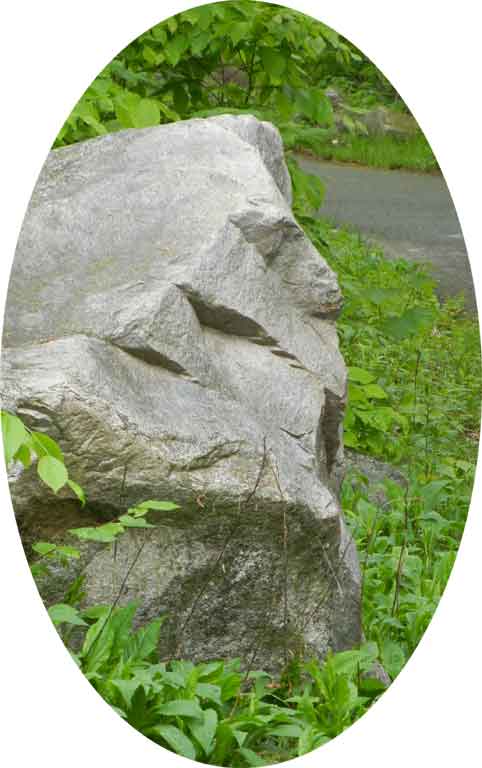
Be the first to comment